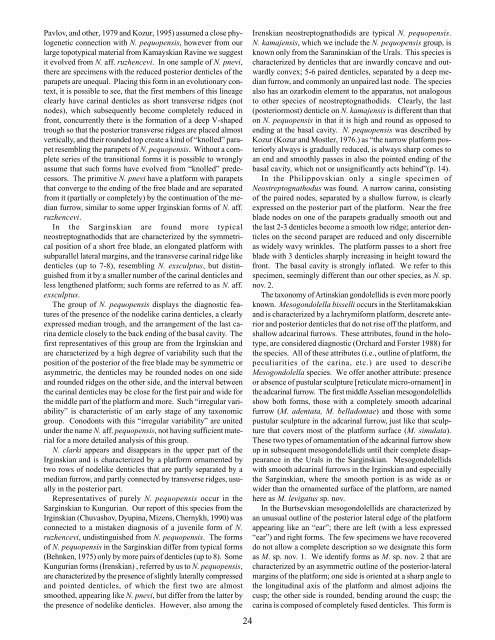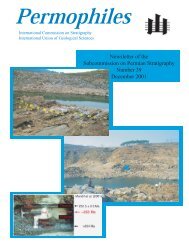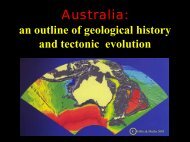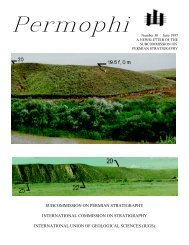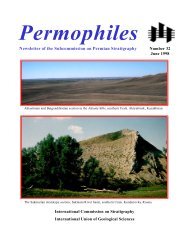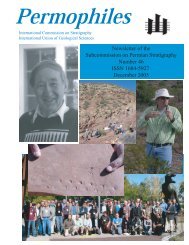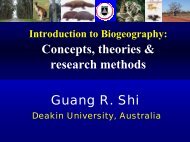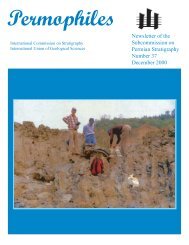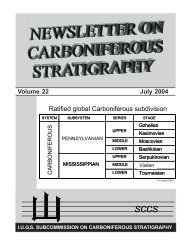Number 31 January 1998 Newsletter of the Subcommission on ...
Number 31 January 1998 Newsletter of the Subcommission on ...
Number 31 January 1998 Newsletter of the Subcommission on ...
Create successful ePaper yourself
Turn your PDF publications into a flip-book with our unique Google optimized e-Paper software.
Pavlov, and o<str<strong>on</strong>g>the</str<strong>on</strong>g>r, 1979 and Kozur, 1995) assumed a close phylogenetic<br />
c<strong>on</strong>necti<strong>on</strong> with N. pequopensis, however from our<br />
large topotypical material from Kamayskian Ravine we suggest<br />
it evolved from N. aff. ruzhencevi. In <strong>on</strong>e sample <str<strong>on</strong>g>of</str<strong>on</strong>g> N. pnevi,<br />
<str<strong>on</strong>g>the</str<strong>on</strong>g>re are specimens with <str<strong>on</strong>g>the</str<strong>on</strong>g> reduced posterior denticles <str<strong>on</strong>g>of</str<strong>on</strong>g> <str<strong>on</strong>g>the</str<strong>on</strong>g><br />
parapets are unequal. Placing this form in an evoluti<strong>on</strong>ary c<strong>on</strong>text,<br />
it is possible to see, that <str<strong>on</strong>g>the</str<strong>on</strong>g> first members <str<strong>on</strong>g>of</str<strong>on</strong>g> this lineage<br />
clearly have carinal denticles as short transverse ridges (not<br />
nodes), which subsequently become completely reduced in<br />
fr<strong>on</strong>t, c<strong>on</strong>currently <str<strong>on</strong>g>the</str<strong>on</strong>g>re is <str<strong>on</strong>g>the</str<strong>on</strong>g> formati<strong>on</strong> <str<strong>on</strong>g>of</str<strong>on</strong>g> a deep V-shaped<br />
trough so that <str<strong>on</strong>g>the</str<strong>on</strong>g> posterior transverse ridges are placed almost<br />
vertically, and <str<strong>on</strong>g>the</str<strong>on</strong>g>ir rounded top create a kind <str<strong>on</strong>g>of</str<strong>on</strong>g> “knolled” parapet<br />
resembling <str<strong>on</strong>g>the</str<strong>on</strong>g> parapets <str<strong>on</strong>g>of</str<strong>on</strong>g> N. pequopensis. Without a complete<br />
series <str<strong>on</strong>g>of</str<strong>on</strong>g> <str<strong>on</strong>g>the</str<strong>on</strong>g> transiti<strong>on</strong>al forms it is possible to wr<strong>on</strong>gly<br />
assume that such forms have evolved from “knolled” predecessors.<br />
The primitive N. pnevi have a platform with parapets<br />
that c<strong>on</strong>verge to <str<strong>on</strong>g>the</str<strong>on</strong>g> ending <str<strong>on</strong>g>of</str<strong>on</strong>g> <str<strong>on</strong>g>the</str<strong>on</strong>g> free blade and are separated<br />
from it (partially or completely) by <str<strong>on</strong>g>the</str<strong>on</strong>g> c<strong>on</strong>tinuati<strong>on</strong> <str<strong>on</strong>g>of</str<strong>on</strong>g> <str<strong>on</strong>g>the</str<strong>on</strong>g> median<br />
furrow, similar to some upper Irginskian forms <str<strong>on</strong>g>of</str<strong>on</strong>g> N. aff.<br />
ruzhencevi.<br />
In <str<strong>on</strong>g>the</str<strong>on</strong>g> Sarginskian are found more typical<br />
neostreptognathodids that are characterized by <str<strong>on</strong>g>the</str<strong>on</strong>g> symmetrical<br />
positi<strong>on</strong> <str<strong>on</strong>g>of</str<strong>on</strong>g> a short free blade, an el<strong>on</strong>gated platform with<br />
subparallel lateral margins, and <str<strong>on</strong>g>the</str<strong>on</strong>g> transverse carinal ridge like<br />
denticles (up to 7-8), resembling N. exsculptus, but distinguished<br />
from it by a smaller number <str<strong>on</strong>g>of</str<strong>on</strong>g> <str<strong>on</strong>g>the</str<strong>on</strong>g> carinal denticles and<br />
less leng<str<strong>on</strong>g>the</str<strong>on</strong>g>ned platform; such forms are referred to as N. aff.<br />
exsculptus.<br />
The group <str<strong>on</strong>g>of</str<strong>on</strong>g> N. pequopensis displays <str<strong>on</strong>g>the</str<strong>on</strong>g> diagnostic features<br />
<str<strong>on</strong>g>of</str<strong>on</strong>g> <str<strong>on</strong>g>the</str<strong>on</strong>g> presence <str<strong>on</strong>g>of</str<strong>on</strong>g> <str<strong>on</strong>g>the</str<strong>on</strong>g> nodelike carina denticles, a clearly<br />
expressed median trough, and <str<strong>on</strong>g>the</str<strong>on</strong>g> arrangement <str<strong>on</strong>g>of</str<strong>on</strong>g> <str<strong>on</strong>g>the</str<strong>on</strong>g> last carina<br />
denticle closely to <str<strong>on</strong>g>the</str<strong>on</strong>g> back ending <str<strong>on</strong>g>of</str<strong>on</strong>g> <str<strong>on</strong>g>the</str<strong>on</strong>g> basal cavity. The<br />
first representatives <str<strong>on</strong>g>of</str<strong>on</strong>g> this group are from <str<strong>on</strong>g>the</str<strong>on</strong>g> Irginskian and<br />
are characterized by a high degree <str<strong>on</strong>g>of</str<strong>on</strong>g> variability such that <str<strong>on</strong>g>the</str<strong>on</strong>g><br />
positi<strong>on</strong> <str<strong>on</strong>g>of</str<strong>on</strong>g> <str<strong>on</strong>g>the</str<strong>on</strong>g> posterior <str<strong>on</strong>g>of</str<strong>on</strong>g> <str<strong>on</strong>g>the</str<strong>on</strong>g> free blade may be symmetric or<br />
asymmetric, <str<strong>on</strong>g>the</str<strong>on</strong>g> denticles may be rounded nodes <strong>on</strong> <strong>on</strong>e side<br />
and rounded ridges <strong>on</strong> <str<strong>on</strong>g>the</str<strong>on</strong>g> o<str<strong>on</strong>g>the</str<strong>on</strong>g>r side, and <str<strong>on</strong>g>the</str<strong>on</strong>g> interval between<br />
<str<strong>on</strong>g>the</str<strong>on</strong>g> carinal denticles may be close for <str<strong>on</strong>g>the</str<strong>on</strong>g> first pair and wide for<br />
<str<strong>on</strong>g>the</str<strong>on</strong>g> middle part <str<strong>on</strong>g>of</str<strong>on</strong>g> <str<strong>on</strong>g>the</str<strong>on</strong>g> platform and more. Such “irregular variability”<br />
is characteristic <str<strong>on</strong>g>of</str<strong>on</strong>g> an early stage <str<strong>on</strong>g>of</str<strong>on</strong>g> any tax<strong>on</strong>omic<br />
group. C<strong>on</strong>od<strong>on</strong>ts with this “irregular variability” are united<br />
under <str<strong>on</strong>g>the</str<strong>on</strong>g> name N. aff. pequopensis, not having sufficient material<br />
for a more detailed analysis <str<strong>on</strong>g>of</str<strong>on</strong>g> this group.<br />
N. clarki appears and disappears in <str<strong>on</strong>g>the</str<strong>on</strong>g> upper part <str<strong>on</strong>g>of</str<strong>on</strong>g> <str<strong>on</strong>g>the</str<strong>on</strong>g><br />
Irginskian and is characterized by a platform ornamented by<br />
two rows <str<strong>on</strong>g>of</str<strong>on</strong>g> nodelike denticles that are partly separated by a<br />
median furrow, and partly c<strong>on</strong>nected by transverse ridges, usually<br />
in <str<strong>on</strong>g>the</str<strong>on</strong>g> posterior part.<br />
Representatives <str<strong>on</strong>g>of</str<strong>on</strong>g> purely N. pequopensis occur in <str<strong>on</strong>g>the</str<strong>on</strong>g><br />
Sarginskian to Kungurian. Our report <str<strong>on</strong>g>of</str<strong>on</strong>g> this species from <str<strong>on</strong>g>the</str<strong>on</strong>g><br />
Irginskian (Chuvashov, Dyupina, Mizens, Chernykh, 1990) was<br />
c<strong>on</strong>nected to a mistaken diagnosis <str<strong>on</strong>g>of</str<strong>on</strong>g> a juvenile form <str<strong>on</strong>g>of</str<strong>on</strong>g> N.<br />
ruzhencevi, undistinguished from N. pequopensis. The forms<br />
<str<strong>on</strong>g>of</str<strong>on</strong>g> N. pequopensis in <str<strong>on</strong>g>the</str<strong>on</strong>g> Sarginskian differ from typical forms<br />
(Behnken, 1975) <strong>on</strong>ly by more pairs <str<strong>on</strong>g>of</str<strong>on</strong>g> denticles (up to 8). Some<br />
Kungurian forms (Irenskian) , referred by us to N. pequopensis,<br />
are characterized by <str<strong>on</strong>g>the</str<strong>on</strong>g> presence <str<strong>on</strong>g>of</str<strong>on</strong>g> slightly laterally compressed<br />
and pointed denticles, <str<strong>on</strong>g>of</str<strong>on</strong>g> which <str<strong>on</strong>g>the</str<strong>on</strong>g> first two are almost<br />
smoo<str<strong>on</strong>g>the</str<strong>on</strong>g>d, appearing like N. pnevi, but differ from <str<strong>on</strong>g>the</str<strong>on</strong>g> latter by<br />
<str<strong>on</strong>g>the</str<strong>on</strong>g> presence <str<strong>on</strong>g>of</str<strong>on</strong>g> nodelike denticles. However, also am<strong>on</strong>g <str<strong>on</strong>g>the</str<strong>on</strong>g><br />
24<br />
Irenskian neostreptognathodids are typical N. pequopensis.<br />
N. kamajensis, which we include <str<strong>on</strong>g>the</str<strong>on</strong>g> N. pequopensis group, is<br />
known <strong>on</strong>ly from <str<strong>on</strong>g>the</str<strong>on</strong>g> Saraninskian <str<strong>on</strong>g>of</str<strong>on</strong>g> <str<strong>on</strong>g>the</str<strong>on</strong>g> Urals. This species is<br />
characterized by denticles that are inwardly c<strong>on</strong>cave and outwardly<br />
c<strong>on</strong>vex; 5-6 paired denticles, separated by a deep median<br />
furrow, and comm<strong>on</strong>ly an unpaired last node. The species<br />
also has an ozarkodin element to <str<strong>on</strong>g>the</str<strong>on</strong>g> apparatus, not analogous<br />
to o<str<strong>on</strong>g>the</str<strong>on</strong>g>r species <str<strong>on</strong>g>of</str<strong>on</strong>g> neostreptognathodids. Clearly, <str<strong>on</strong>g>the</str<strong>on</strong>g> last<br />
(posteriormost) denticle <strong>on</strong> N. kamajensis is different than that<br />
<strong>on</strong> N. pequopensis in that it is high and round as opposed to<br />
ending at <str<strong>on</strong>g>the</str<strong>on</strong>g> basal cavity. N. pequopensis was described by<br />
Kozur (Kozur and Mostler, 1976.) as “<str<strong>on</strong>g>the</str<strong>on</strong>g> narrow platform posteriorly<br />
always is gradually reduced, is always sharp comes to<br />
an end and smoothly passes in also <str<strong>on</strong>g>the</str<strong>on</strong>g> pointed ending <str<strong>on</strong>g>of</str<strong>on</strong>g> <str<strong>on</strong>g>the</str<strong>on</strong>g><br />
basal cavity, which not or unsignificantly acts behind”(p. 14).<br />
In <str<strong>on</strong>g>the</str<strong>on</strong>g> Philippovskian <strong>on</strong>ly a single specimen <str<strong>on</strong>g>of</str<strong>on</strong>g><br />
Neostreptognathodus was found. A narrow carina, c<strong>on</strong>sisting<br />
<str<strong>on</strong>g>of</str<strong>on</strong>g> <str<strong>on</strong>g>the</str<strong>on</strong>g> paired nodes, separated by a shallow furrow, is clearly<br />
expressed <strong>on</strong> <str<strong>on</strong>g>the</str<strong>on</strong>g> posterior part <str<strong>on</strong>g>of</str<strong>on</strong>g> <str<strong>on</strong>g>the</str<strong>on</strong>g> platform. Near <str<strong>on</strong>g>the</str<strong>on</strong>g> free<br />
blade nodes <strong>on</strong> <strong>on</strong>e <str<strong>on</strong>g>of</str<strong>on</strong>g> <str<strong>on</strong>g>the</str<strong>on</strong>g> parapets gradually smooth out and<br />
<str<strong>on</strong>g>the</str<strong>on</strong>g> last 2-3 denticles become a smooth low ridge; anterior denticles<br />
<strong>on</strong> <str<strong>on</strong>g>the</str<strong>on</strong>g> sec<strong>on</strong>d parapet are reduced and <strong>on</strong>ly discernible<br />
as widely wavy wrinkles. The platform passes to a short free<br />
blade with 3 denticles sharply increasing in height toward <str<strong>on</strong>g>the</str<strong>on</strong>g><br />
fr<strong>on</strong>t. The basal cavity is str<strong>on</strong>gly inflated. We refer to this<br />
specimen, seemingly different than our o<str<strong>on</strong>g>the</str<strong>on</strong>g>r species, as N. sp.<br />
nov. 2.<br />
The tax<strong>on</strong>omy <str<strong>on</strong>g>of</str<strong>on</strong>g> Artinskian g<strong>on</strong>dolellids is even more poorly<br />
known. Mesog<strong>on</strong>dolella bisselli occurs in <str<strong>on</strong>g>the</str<strong>on</strong>g> Sterlitamakskian<br />
and is characterized by a lachrymiform platform, descrete anterior<br />
and posterior denticles that do not rise <str<strong>on</strong>g>of</str<strong>on</strong>g>f <str<strong>on</strong>g>the</str<strong>on</strong>g> platform, and<br />
shallow adcarinal furrows. These attributes, found in <str<strong>on</strong>g>the</str<strong>on</strong>g> holotype,<br />
are c<strong>on</strong>sidered diagnostic (Orchard and Forster 1988) for<br />
<str<strong>on</strong>g>the</str<strong>on</strong>g> species. All <str<strong>on</strong>g>of</str<strong>on</strong>g> <str<strong>on</strong>g>the</str<strong>on</strong>g>se attributes (i.e., outline <str<strong>on</strong>g>of</str<strong>on</strong>g> platform, <str<strong>on</strong>g>the</str<strong>on</strong>g><br />
peculiarities <str<strong>on</strong>g>of</str<strong>on</strong>g> <str<strong>on</strong>g>the</str<strong>on</strong>g> carina, etc.) are used to describe<br />
Mesog<strong>on</strong>dolella species. We <str<strong>on</strong>g>of</str<strong>on</strong>g>fer ano<str<strong>on</strong>g>the</str<strong>on</strong>g>r attribute: presence<br />
or absence <str<strong>on</strong>g>of</str<strong>on</strong>g> pustular sculpture [reticulate micro-ornament] in<br />
<str<strong>on</strong>g>the</str<strong>on</strong>g> adcarinal furrow. The first middle Asselian mesog<strong>on</strong>dolellids<br />
show both forms, those with a completely smooth adcarinal<br />
furrow (M. adentata, M. bellad<strong>on</strong>tae) and those with some<br />
pustular sculpture in <str<strong>on</strong>g>the</str<strong>on</strong>g> adcarinal furrow, just like that sculpture<br />
that covers most <str<strong>on</strong>g>of</str<strong>on</strong>g> <str<strong>on</strong>g>the</str<strong>on</strong>g> platform surface (M. simulata).<br />
These two types <str<strong>on</strong>g>of</str<strong>on</strong>g> ornamentati<strong>on</strong> <str<strong>on</strong>g>of</str<strong>on</strong>g> <str<strong>on</strong>g>the</str<strong>on</strong>g> adcarinal furrow show<br />
up in subsequent mesog<strong>on</strong>dolellids until <str<strong>on</strong>g>the</str<strong>on</strong>g>ir complete disappearance<br />
in <str<strong>on</strong>g>the</str<strong>on</strong>g> Urals in <str<strong>on</strong>g>the</str<strong>on</strong>g> Sarginskian. Mesog<strong>on</strong>dolellids<br />
with smooth adcarinal furrows in <str<strong>on</strong>g>the</str<strong>on</strong>g> Irginskian and especially<br />
<str<strong>on</strong>g>the</str<strong>on</strong>g> Sarginskian, where <str<strong>on</strong>g>the</str<strong>on</strong>g> smooth porti<strong>on</strong> is as wide as or<br />
wider than <str<strong>on</strong>g>the</str<strong>on</strong>g> ornamented surface <str<strong>on</strong>g>of</str<strong>on</strong>g> <str<strong>on</strong>g>the</str<strong>on</strong>g> platform, are named<br />
here as M. levigatus sp. nov.<br />
In <str<strong>on</strong>g>the</str<strong>on</strong>g> Burtsevskian mesog<strong>on</strong>dolellids are characterized by<br />
an unusual outline <str<strong>on</strong>g>of</str<strong>on</strong>g> <str<strong>on</strong>g>the</str<strong>on</strong>g> posterior lateral edge <str<strong>on</strong>g>of</str<strong>on</strong>g> <str<strong>on</strong>g>the</str<strong>on</strong>g> platform<br />
appearing like an “ear”; <str<strong>on</strong>g>the</str<strong>on</strong>g>re are left (with a less expressed<br />
“ear”) and right forms. The few specimens we have recovered<br />
do not allow a complete descripti<strong>on</strong> so we designate this form<br />
as M. sp. nov. 1. We identify forms as M. sp. nov. 2 that are<br />
characterized by an asymmetric outline <str<strong>on</strong>g>of</str<strong>on</strong>g> <str<strong>on</strong>g>the</str<strong>on</strong>g> posterior-lateral<br />
margins <str<strong>on</strong>g>of</str<strong>on</strong>g> <str<strong>on</strong>g>the</str<strong>on</strong>g> platform; <strong>on</strong>e side is oriented at a sharp angle to<br />
<str<strong>on</strong>g>the</str<strong>on</strong>g> l<strong>on</strong>gitudinal axis <str<strong>on</strong>g>of</str<strong>on</strong>g> <str<strong>on</strong>g>the</str<strong>on</strong>g> platform and almost adjoins <str<strong>on</strong>g>the</str<strong>on</strong>g><br />
cusp; <str<strong>on</strong>g>the</str<strong>on</strong>g> o<str<strong>on</strong>g>the</str<strong>on</strong>g>r side is rounded, bending around <str<strong>on</strong>g>the</str<strong>on</strong>g> cusp; <str<strong>on</strong>g>the</str<strong>on</strong>g><br />
carina is composed <str<strong>on</strong>g>of</str<strong>on</strong>g> completely fused denticles. This form is


